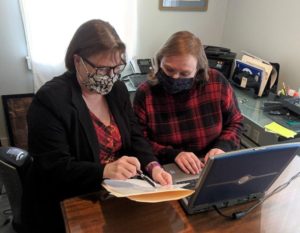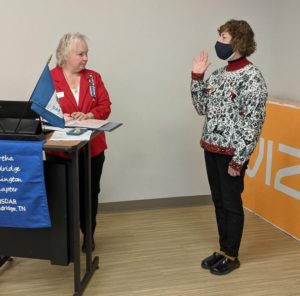Would You Like to Join the DAR?
Would you like to join the DAR?
When I was 18, if I had been asked that question, I would have responded, “Why?” for this reason: I had the impression that members of the DAR were stuffy old ladies who liked to drink tea and wear big hats and hold their noses in the air because of their ancestry. What a misconception that was! I learned the real scoop on the National Society Daughters of the American Revolution (NSDAR) when I researched my own ancestry, applied for membership, and became a member of the Martha Dandridge Washington Chapter (MDW).
The MDW Chapter, which is approaching its fifth anniversary, exemplifies what the NSDAR has always stood for. Prior to the NSDAR founding, a number of men’s organizations were established to encourage patriotism and honor patriot ancestors. Women were excluded. Since the founding of the NSDAR on October 11, 1890, more than 1 million women have joined as an outlet for their own desire to honor their patriot ancestors who gave their lives and treasures for freedom and independence. For more than 130 years, the members have achieved that while promoting the objectives of historical preservation, education, and patriotism.
In the realm of historical preservation, the national organization awards grants to restore historical sites, erect markers to identify locations of historical events, and preserve items including textiles, furniture, and documents. The NSDAR Library in Washington, D.C., is the repository of “180,000 books, 300,000 research files, thousands of manuscript items, and special collections on Native American, African American and women’s history, genealogy and culture.” In the past three years, the MDW Chapter has marked the graves of two patriots, James McCuistion and Joseph Hill.
In support of education, the NSDAR encourages members to volunteer to support individual students and classrooms. Some members tutor students who need an extra boost or teach English to new immigrants. The Community Classroom Committee solicits and catalogs lesson plans prepared by members which can be requested by the teachers free of charge for use in their classrooms. The lessons can focus on any area of the curriculum and address Common Core Standards and/or State Standards. In addition to that, chapter members donate materials for use in classrooms, food for backpack programs, and hygiene supplies for distribution by school nurses. Members are also available to visit classrooms and share presentations of a historical nature. An MDW member regularly presents a program on Zoom for toddlers and preschoolers through Parrott-Wood Memorial Library, which distributes packets with lesson and craft materials.
Finally, the fragrance of patriotism infuses every activity of the membership. Veterans are honored on Veterans Day and throughout the year. Recognition is given to the spouses and other family members who support them. The NSDAR has a database of more than 148,000 proved Revolutionary War patriot ancestors. As more are identified, they are added to the database. Last year alone, 643 new patriot names were added.
With committees that span such areas as American Indians and Conservation to Service to America and Women’s Issues, new members can find ways to serve that fit about any taste.
Ok! Let’s say a woman age 18 or older is curious now and wants to consider joining the MDW Chapter. The first step is to ask any member of the chapter for direction or to contact Registrar Karen McFarland directly at (865) 258-8670 or mdw.registrar@gmail.com. Registrar McFarland will set up a meeting where the following will be discussed regarding the chapter: 1. Who we are, 2. What we do, 3. Where we meet, 4. Why someone should join, 5. What she needs to do to join, 6. If she already knows of a patriot ancestor, and 7. What it costs to join.
Next, the registrar asks the prospective member to collect the necessary genealogical information on the first three generations of her family: applicant’s birth certificate, applicant’s parents’ birth or death certificates, and applicant’s grandparents’ birth or death certificates. With this information, Registrar McFarland creates a lineage chart and searches for a patriot ancestor.
If a patriot ancestor is found, then the prospective member can search for the necessary birth, marriage, and death documents and obtain photocopies to submit with her application. If it is difficult to find a patriot, Registrar McFarland can request assistance from the State Application Team to locate documents that are in-state. If the documents are in another state, the registrar can enlist the aid of the national America 250! Task Force.
It is amazing what this research can uncover. With grandfathers named Busdeker (Buβdieker) and Wice (Weiβ), I had thought that all of my ancestors had come from Germany in the mid-1850s. However, when I got on to Ancestry.com, I discovered that my Bacher ancestor came from Germany and my Clifford ancestor came from England prior to the Revolutionary War, and distant relatives in Wellington, OH, had already proved John Clifford as a patriot when they joined the NSDAR back in the 1950s.
Usually, documents for six to eight generations of ancestors are required to prove an applicant’s ancestry from the present to the patriot. However, if the name of the patriot is not already in the NSDAR database, the applicant can prove the patriot by finding documents in Fold3.com, which is a military database, or in historical records. In rare cases the photo of a tombstone may be accepted.
Often people think that to be proved as a patriot, the person must have signed the Declaration of Independence or served in the Continental Army in the North or in a militia in the South. However, a person can be proved as a patriot if he/she was a civil servant or supported the war effort with any of the following: food, taxes, first aid, a place to camp, or grazing land for horses. Proper documentation is required. French nationals who gave military or naval service in the American theater of war can also qualify.
In order to be considered for membership, the prospective member must be sponsored by two members. After the application and supporting documents are submitted to the national office, the local chapter votes on the prospective member. If all of the documentation is in order, the application is usually approved within six weeks. Then the chair of the Membership Committee notifies the new member of her acceptance. At the next chapter meeting, the new member is inducted and takes the oath of membership.
The final step is to attend the monthly chapter meetings and to dive into service in the member’s areas of interest. At this point, Registrar McFarland says with a twinkle in her eye, “Your new favorite colors are red, white, and blue.”
During my three and a half years in the MDW NSDAR chapter, my misconception of membership has changed. I am old (71), but we have members much younger than I am. I do like hats and can tolerate an occasional cup of tea. I don’t think I am stuffy. More than anything, I love the U.S.A. just like all of the other women who are called Daughters of the American Revolution.

MDW Registrar Karen McFarland works with prospective member Dawn Mosteit to research her patriot ancestry.
MDW Chaplain Elizabeth Finchum administers the membership oath to new member Pam Teague.
Submitted by Jane Busdeker, Corresponding Secretary, MDW Chapter, NSDAR
janekaybus@gmail.com













